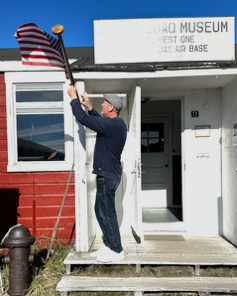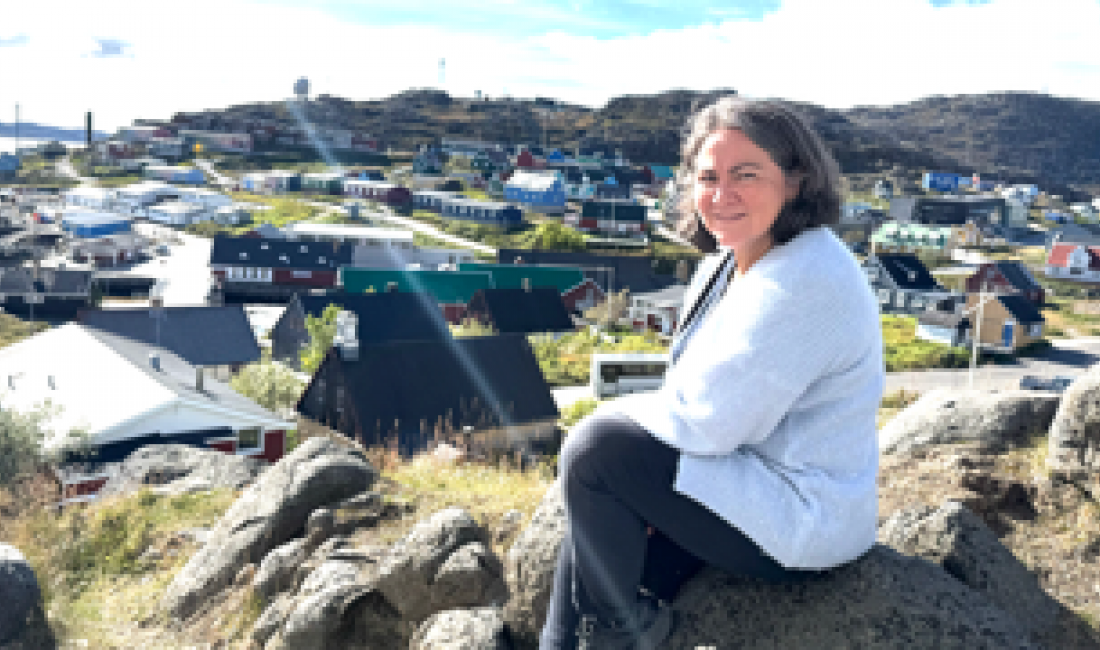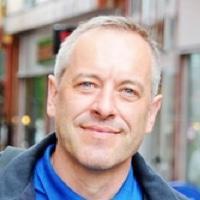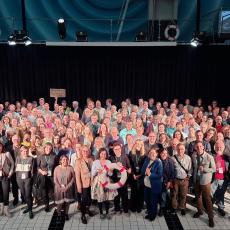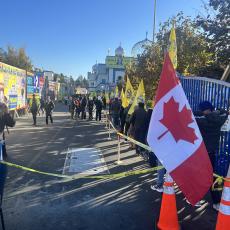In Advance of April 1 Local Elections, Greenland Contemplates Self-Governance
Photos by Bruno Kaufmann
“This is the last American flag,” says Ole Guldager as he hoists a yellowed version of the stars-and-stripes outside the wooden door of his very own little museum at Narsarsuaq airport.
The last time American officials took down the flag was in November 1958, when the U.S. left the air base here in the south of the world’s biggest island, Greenland.
The base was then given to the Danes, which at that time had annexed its former colony and established a weather station where Guldager’s father worked. Little Ole spent his childhood years in this small village on the Eriksfjord, at the edge of the gigantic inland ice shield covering more than 80 percent of Greenland.
It took another 30 years until the airport was given back to Greenland. It was then, in 1989, that Greenland regained parts of its independence with its own elected parliament (Inatsisartut) and government (Naalakkersuisut).
The airport’s history is now coming to an end, in a way that will impact Guldager’s own future, and may tell the world something about the crossroads at which Greenland itself now sits.
“Now it’s all over,” Guldager tells me. “Next year Narsarsuaq Airport will be closed and we have to move away from here.”
This represents uncertainty, and perhaps a shift for Greenland.
For many years, Greenland’s national government and parliament—which are based in the capital of Nuuk, 465 kilometers northwest from Narsarsuaq—have invested heavily in building Greenland into a nation. Among the nation-building measures are the establishment of a national university (Ilisimatusarfik), the drafting of national constitution—and the replacement of the remote former American military airports with new civilian airports close to the main population centers.
Such a Greenlandic population center is Qaqortoq. It may have just 3,000 inhabitants but that makes it the 4th biggest city on an island with a population of 57,000.
To get to Qaqortoq from Narsarsuaq, I need to take a commuter boat with the name Iluliaq, which is Greenlandic for “Iceberg.” That is appropriate. There are many icebergs here in the south of the island, where the polar seas meet the Gulf stream. Some 113 years ago, it was a collision with an “Iluliaq” just south of Qaqortoq, that sunk The Titanic, killing more than 1,500 of 2,220 passengers on board.
On my recent trip aboard the commuter boat, I was one of four passengers.
On our journey, we passed the Kuannersuit mountains at Narsaq, where enormous deposits of rare metals have been found. These metals have made Narsaq, and Greenland, one of the globe’s geopolitical hotspots.
In Qaqortoq’s city hall, I met with Tine Pars. The 60-year-olld epidemiologist and former rector of the University of Greenland., moved to Qaqortoq to become Director of Kujalleq—the name for the South Greenland Municipality four years ago.
“I never expected this job to become the hardest I ever had,” she confessed in a long conversation about the challenges of local democracy in her office.
“On the one hand, we are one of the richest places in the world with all the resources and opportunities,” she said, referencing the metals, the enormous nearby fish population, and the possibilities for developing tourism and space research centers.
On the other, “our political heritage and structures still limits these possibilities very much: we have big social problems, we have many poor people here and we lack power and money.”
Greenland has been populated by Inuit people for more than 3,000 years. About 1,000 years ago, a first ship of Norwegians Vikings led by Erik the Red reached south Greenland. But the tough environments were too harsh even for Vikings. And the Greenlanders had their peace until a Danish missionary, Hans Egede, reached the region of today’s capital Nuuk in 1721.
Even after becoming a Danish colony, Greenlanders mostly did as they wished and made their living from hunting whales and seals and fishing along the almost 44,000-kilometer coastline—until the United States became interested.
Starting in the late 19th century, American presidents have expressed interest in getting Greenland in one way or another. There have been seven such episodes of presidential efforts to grab Greenland, including the current bid by Donald Trump.
Greenlanders have been ambivalent about the U.S. interest. There was appreciation for the protection that Americans provided during World War II and in the first few post-war years—protection which offered the country its first opportunity to declare full independence. But that possibility was squelched in 1953 when Denmark, ignoring a call from the United Nations for decolonization, formally annexed its Greenland colony, thus expanding its national territory by more than 95 percent.
Denmark followed up with relentless ‘Danification” programs, involving forced adoptions and sterilizations of Greenlandic women. The Danes also exploited natural resources, including the infamous Cryolite mine in Ivittuut, not far from Qaqortoq.
Such exploitation produced resentments, and efforts for independence. In a 2008 referendum, Greenland gained the right to control its own natural resources. It also can unilaterally declare independence from the Danish Kingdom.
But its political, legal and financial structure are still very much linked to Denmark. Also, Greenland does not control immigration, which contributes to a lack of workers on the island for all new businesses. And then you have the Danish cops (Politi), who still ensure the law and order locally.
For Qupanuk Olsen, who was born in Qaqortoq in 1985 and is Greenland’s first and only female mining engineer, this kind of post-colonial relationship needs to change:
"We finally have to address all the bad things Denmark has brought to Greenland, and become a fully independent country,” Olsen told me during a conversation in Greenland’s most modern settlement, Qinngorput, just outside the newly opened international airport in Nuuk.
As Greenland’s biggest influencer on social media, Olsen ran on March 4 as a candidate in the most watched national elections in Greenland’s history. She won one of the 31 seats. Her plan is to become Greenland’s first elected president within the next ten years.
“To get there we do not just need a better economy and more people, but also a functioning local democracy,” she said.
A stronger local democracy is both a path to, and a measure of local independence. Local governance here has a long history—it is how Greenlanders governed themselves for thousands of years, and it is how indigenous people achieved resilience in one of the most inhospitable corners of the world.
On April 1, Greenlanders will hold local elections across Greenland five municipalities. On my visit in the run-up to the elections, many people told me they want to further decentralize the governing structures of the island.
Right now, there is signature gathering underway on proposals in the South Greenland municipality of Kujalleq to open new city halls in places like Nanortalik and, yes, Narsarsuaq.
Such idea may be longshots, but they point to a new math that is about local control, rather than colonization. Instead of the rehoisting of foreign flags—as the American president suggests—the locals of Greenland want nothing more than to govern themselves.
